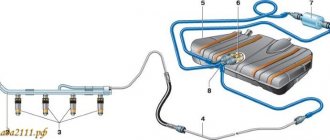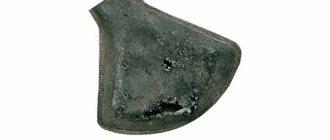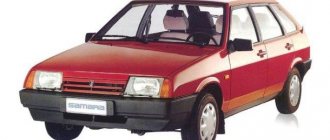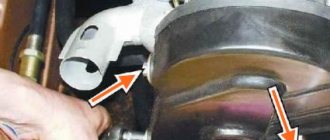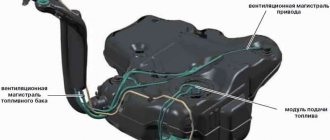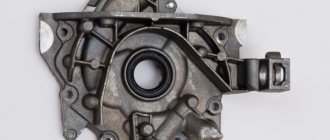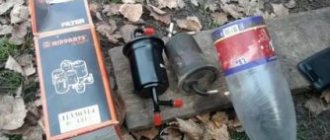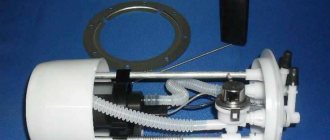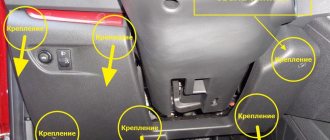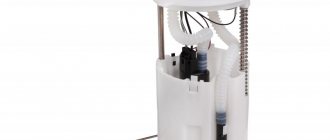The fuel pump plays a key role in the design of the car, and if it malfunctions, it will need to be replaced. If the device is faulty, the engine will experience unstable operation, and if it fails completely, the engine will not be able to start. In this case, you will need to resort to replacing the fuel pump on the Lanos, since this element is irreparable and, in the event of a breakdown, must be replaced. The process of replacing the device is the same for Chevrolet, Daewoo, ZAZ Lanos (1.4, 1.5 and 1.6), as well as Sens and Chance.
How to determine a faulty fuel pump on Lanos
The main sign of a fuel pump malfunction is the absence of the characteristic buzzing of the electric motor when the key is turned in the ignition. However, in this case, you should not rush to buy a new electric pump and install it in place of the existing one. After all, the absence of signs of inoperability can be caused by a burnt-out fuse link F10 under the hood. The first step is to check the serviceability of the fuse, and if the fuse link burns out, the element should be replaced.
A fuel pump malfunction can be caused by a failure of the relay, which is also located in the mounting block under the hood of the Lanos car. The relay rarely fails, but if the fuse is working, you should check it. The surest way to check the serviceability of the relays is to swap them. If, after replacing the relay, the fuel pump starts working, this means that a new relay needs to be installed, and this will complete the entire repair.
If the fuse and relay are working properly, you can judge that the fuel pump has failed. Moreover, its malfunction is of two types:
- Complete failure when the device shows no signs of life
- Partial malfunction - when the fuel pump operates intermittently
If in the case of a complete failure of the device everything is clear, then with a partial failure things are more complicated. In this case, there is no need to rush to change the pump until it is clearly established that it is faulty. Interruptions in the operation of the fuel pump may occur for the following reasons:
- Fuel pump strainer is clogged. Often drivers do not pay attention to this element, which leads to interruptions in the operation of the device, as well as a reduction in its service life
- Malfunction of the fuel filter located after the fuel pump. It is located in the engine compartment, and if it gets dirty, the load on the device will increase, resulting in interruptions
- Reduced quality of contact connections - an electric pump is an electrical device powered from the vehicle’s on-board network. In case of deterioration of contacts, broken wires or violation of insulation integrity, interruptions in the operation of the device will be observed
Before resorting to replacing the fuel pump, you should eliminate the above symptoms. Characteristic features of an electric pump malfunction are the following:
- Difficulty starting the engine
- The engine starts and stalls
- Extraneous noises in the operation of the fuel pump
- Reduced engine power
It is not recommended to drive a car with a faulty fuel pump, as at any moment it may stop functioning altogether. In this case, it will be impossible to drive a car, so at the first sign of a malfunction of the device in question, it should be replaced.
Checking the serviceability of the Chevrolet Lanos fuel pump relay
The well-known front-wheel drive Chevrolet Lanos, also known as Deo Lanos and ZAZ Chance, is equipped with a gasoline eight-valve engine with a displacement of 1.5 liters and a power of 86 hp. pp., is characterized by a reliable design and good controllability. Despite good technical characteristics, there are cases when, after turning on the ignition, the fuel pump does not make a characteristic sound, that is, it does not work or, on the contrary, constantly hums. These signs are a reason to check the serviceability of the Chevrolet Lanos fuel pump relay.
Causes of fuel pump failure
If the Lanos car engine does not start, then do not rush to conclusions. Even the absence of a characteristic sound in the area of the fuel tank does not mean that the device is faulty. One of the important elements in a car is the crankshaft position sensor. If it is not working properly, then the engine will not be able to start. When the ECU does not receive data from the DPKV, no power will be supplied to the electric pump. The driver may think that the fuel pump is faulty and resort to replacing it, but after successfully completing this procedure, the effect when starting the engine will be identical. That is why it is important to first establish the exact cause of the malfunction, and only then resort to eliminating it.
Features of replacing the fuel pump on Chevrolet and Daewoo Lanos
The fuel pump for Lanos is a cylindrical part that is placed inside a plastic flask. Many people do not want to waste time dismantling the fuel pump, so they buy an assembled fuel pump module. As a result, you have to overpay a lot. If the fuel pump on a Lanos is faulty, but the module is not damaged, then only the failed part needs to be replaced.
A module or block is a device that consists of a fuel intake, a fuel pump, a fuel gauge sensor and a low level alarm, as well as a filter. The need to replace the module arises in rare cases when the plastic flasks of the device are damaged. When it comes to replacing the fuel pump, the insert itself or the electric motor with the impeller changes.
Replacing the fuel pump Chevrolet Lanos / ZAZ Chance (Chevrolet Lanos, ZAZ CHANCE, Sens)
| If engine power drops, increased noise occurs, or whines are periodically heard when the fuel pump is operating, then most likely the fuel pump has failed. |
| Pre-check the pressure in the fuel supply system in the following order. |
| 1. Check the serviceability of the fuel pressure regulator (see here) |
| 2. If the pressure in the system is less than 250 kPa (2.5 kgf/cm2), replace the fuel filter |
| If in this case the pressure does not increase, the fuel pump must be replaced, since the pump has a difficult-to-disassemble design and its elements are not supplied separately as spare parts. |
| You will need: a flat blade screwdriver, a container to drain the fuel from the fuel pump module. |
| 1. Reduce the pressure in the power system (see here) |
| 2. Disconnect the wire from the negative terminal of the battery. |
|
6.Push the wire harness block clamp to the right...
| ||
8.Squeezing the plastic clips, disconnect the tips of the fuel drain line from the pump fittings...
| ||
10.Use a screwdriver to turn the pressure ring of the fuel pump module counterclockwise until the grooves in the ring coincide with the protrusions of the fuel tank flange...
| ||
12.Having noted the position of the fuel pump module relative to the fuel tank (to facilitate its installation during reassembly), carefully remove the module and drain the fuel from it into a previously prepared container.
| ||
| 13. Remove the O-ring and inspect it. Be sure to replace the ring if it is torn or severely compressed. |
... by pressing the latch of the wiring harness block, disconnect the block from the fuel module cover connector. To remove the sensor and resistor, it is necessary to remove the tips of their wires from the wiring harness block (the wires for the sensor are blue and white, and the wires for the resistor are yellow and gray). Mark the location of the wires in the block.
Through the two holes of the block (shown by the arrow), we alternately press with an awl onto the protrusions of the wire tip retainer...
...and use pliers to remove the wire tip retainer from the block.
Using an awl or a paper clip wire, press the tongue of the block that holds the tip of the desired wire...
... and remove the wire tip from the block. Similarly, we remove the tips of other wires from the block.
To replace the resistor of the fuel reserve indicator lamp, remove it from the clamp...
... and remove the resistor by pulling its two wires through the hole in the module body. To remove the fuel level sensor...
... using a slotted screwdriver, we remove the sensor and resistor clamp.
Using a screwdriver, pry off the sensor...
.. slide it along the guides of the module body...
... and remove the fuel level indicator sensor, leading its wires through the hole in the module housing. We assemble and install the fuel module in the reverse order. If the sealing ring of the module cover fails, replace it with a new one.
| When installing the fuel module into the tank, align the cutout in the fuel module cover with the tongue on the flange of the tank opening. Before closing the hatch cover in the floor of the body under the rear seat, it is necessary to check the tightness of the fuel module connections. To do this, connect the wire terminal to the “negative” terminal of the battery and turn on the ignition. |
| The fuel pump module can be installed in the fuel tank in only one position, since the lower beveled part of the module cup rests with its two rubber buffers on the inclined wall of the fuel tank. When installing the module into the tank in any other position, it will not be possible to secure it with a clamping ring. |
lanos-chevrolet.ru
How to replace the fuel pump on Lanos, Sense and Chance
The process of replacing the device in question is not difficult, however, its implementation must be carried out with strict adherence to the sequence of actions. To replace the fuel pump on a Lanos, you will first need to remove the fuel module, then disassemble it and install a new fuel pump in place of the faulty device. Let's look at how to do this correctly below.
- First you need to remove the fuse or relay in the mounting block under the hood. The photo below shows which fuse and relay are responsible for the operation of the fuel pump on Lanos
- After this we try to start the engine. This procedure is necessary to reduce the fuel pressure in the fuel line.
- Disconnect the negative terminal from the battery and move to the location of the fuel module. It is located under the rear sofa on the right side
- The sofa seat is attached using one “12” bolt
- After removing the rear sofa seat, we find a protective cover that needs to be pryed off with a screwdriver to remove it
- Under the cover there is a chip with wires and two tubes for supplying gasoline and return drainage. Before proceeding further, you should first carefully remove contaminants to prevent them from getting inside the tank.
- To remove the chip, you need to move the orange lock to the side towards the fuel pipes, and then press the tongue and pull the block to the side
- Next, the hoses are removed. To do this, press the white latches and then pull them to the side.
- At the next stage, we take a punch or a chisel with a hammer, and work on the locking ring, through which the module is attached to the tank. Turn the ring to the side counterclockwise until it disengages
- The retaining ring is removed
- Carefully, grasping the chip, you need to remove the module from the tank, pointing it to the right side
- When removing it, it is important not to bend the float, which is located at the very bottom
- After removing the module, you will see that there is gasoline inside the flask. It can be drained back into the tank or other container
- The extracted part is placed on the table, after which we proceed to disassemble it to remove the fuel pump
- Using a screwdriver on the three latches in the plastic outer flask, you need to remove the top cover
- Disconnect the power supply for the sensor and fuel level indicator in the tank
- You can detach the float so that it does not interfere. It is attached using a plastic plate that needs to be squeezed and pulled out
- Next, you can heat the outer flask with a hairdryer to remove the inner part along with the fuel pump. When it warms up, it will be easier to dismantle it, but in any case you will need to bend the steel rod into a hook and use it to pry off the plastic part with the fuel pump
- There is dirt inside the glass that needs to be removed
- Remove the fuel pump strainer. If it is clean, then it does not need to be changed, but it is better to replace it so that you do not have to repeat the procedure again in the near future. A detailed description of how to replace the fuel pump mesh on Lanos, Sense and Chance is described here
- To remove the mesh, you need to pry off the retaining ring with a screwdriver
- The fuel pump is attached using plastic latches that need to be pressed out
- After removing the pump, you should unclip the chip with the power wires
- Loosen the clamp securing the tube. To do this you will need to use pliers. This clamp is disposable, so it will need to be replaced during assembly.
- Disconnect the tube from the fuel pump using a screwdriver as a lever
- Now, instead of the faulty fuel pump, we install a new one. To do this, install the tube in place and fix it with a new clamp of 8-12 mm
Checking the fuel pump directly
Having suffered a fair amount, it’s time to suffer even more... To gain access to the fuel pump cover, you need to “pull” the rear sofa: it is attached in two places to the floor (seen in the photo above), approximately in those places you need to pull. We removed the sofa - we unscrew the cover with a screwdriver and see the fuel pump connector (in the photo above on the right). To check the fuel pump directly , excluding all other elements of the car's electrical wiring, you need to apply voltage to the fuel pump directly from the battery. To do this, you first need to find which contacts in connector C901 are responsible for powering the fuel pump.
The picture above shows a connector (or, as people say, a chip) of a fuel pump (view from the pins). I didn’t remove the fuel pump from the gas tank, I just used a long wire to connect it to the battery. The fuel pump turned out to be alive!
Having experienced some bewilderment in connection with the diagnostic information received ( the pump is working, the fuse is working, the relay is working - all the obvious participants in the circuit are working! ), I decided to use a tester to check the voltage on the second half of the fuel pump connector (C901), coming from the bowels of the car. There was tension on him! That is, voltage was supplied to the fuel pump, the fuel pump was working, but did not work! How is this possible, you ask?
Why this situation has arisen and what transient contact resistance is, I will tell you in the next part of my adventures as a car enthusiast: Lanos (Lanos 1.5) will not start, part 2: the “Check” does not light up, the fuel pump or “C301 connector” does not hum
Manufacturers of fuel pumps for Lanos - what to choose and how much they cost
It is recommended to install an original General Motors fuel pump on Lanos. This item has an article number - 96344792. The main disadvantage of the original fuel pump is that it costs more than $300. Alternative fuel pump options for Lanos, Sens and Chance cars:
- Bosch - has article number 1987580030
- Marco - catalog number 22512
- Stellox - article number 10-01693-SX
- FSO - catalog number 580453453
- TSN - article 7.2.21
- SHIN KUM is one of the cheapest fuel pump models from a Chinese manufacturer. Article number SK 070/SK0580453453
- Japan Line - article number FJP 058045 J
You can find many other manufacturers, but the most important thing when purchasing is to consider the price of the fuel pump. On average, a high-quality electric fuel pump for Lanos, Sense and Chance costs about $100. It is not recommended to purchase devices that cost 10-30 dollars, since they will soon need to be replaced again.
In conclusion, we must summarize and note that the process of replacing an electric fuel pump does not take much time, and every car owner can complete the procedure. By following the sequence of actions described in the material and adhering to the safety instructions, replacing the fuel pump on Lanos, Sense and Chance will be done correctly and quickly.
source
All about the fuel filter on the Chevrolet Lanos
The following two tabs change content below.
- About the expert:
Alexey “technical specialist”
I'm just sick of cars. I try to study in detail every car I have owned. I enjoy driving at night on city streets. I try to do my own repairs on my cars!
According to the manufacturer's recommendations, the fuel filter on a Chevrolet Lanos must be changed every 10,000 kilometers.
This is what the fuel filter mount looks like.
With not particularly intense driving, the frequency may be approximately once a year .
To ensure that the fuel system is in perfect order, preventive measures in this time range will be sufficient. However, under certain objective conditions, more frequent replacement may be necessary.
The replacement procedure when the car is operated is as follows
- High dustiness of the area;
- The quality of the fuel being poured.
Considering these two factors, it is best to change the filter when the mileage reaches 5,000–6,000 kilometers. How to make sure the filter is completely clogged?
Troubleshooting
- The engine runs jerkily at high speeds;
- Jerky operation of the engine is characteristic even when driving in low gears.
These two factors begin to appear gradually in an increasing progression. At first, signs of the first will appear, and over time, the second will clearly manifest itself. It is not at all necessary to wait for symptoms. It's better to act in advance.
